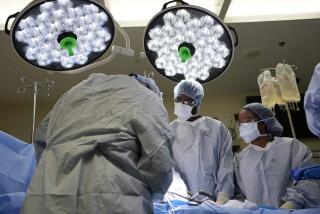Lungs can be ‘fixed’ before transplantation, study finds
- Share via
For decades, heart and lung transplant surgeons have followed a strict directive: Get the donor organ into the recipient as soon as possible.
That practice may be changing. In a study published Wednesday in the New England Journal of Medicine, researchers said the number of donor lungs and successful transplants may be dramatically increased by treating the organs on a perfusion machine for several hours before transplantation.
The technique marks a paradigm shift in the transplantation field, experts noted. About 85% of lungs made available for donation are not used due to tissue damage that potentially could be repaired with perfusion or other techniques.
“We won’t just transplant an organ,” said Dr. Shaf Keshavjee, the senior author of the study and director of the Toronto Lung Transplant Program at Toronto General Hospital. “We will diagnose it, fix it, make it OK and then transplant it.”
Variations on the pre-transplant treatment concept are also being tried on kidneys, livers and hearts. Lungs, however, provide a unique opportunity because they are greatly needed and appear so amenable to perfusion treatment, said John Dark, a professor of cardiothoracic surgery at Newcastle University, U.K., and president of the International Society for Heart & Lung Transplantation.
“This is the most exciting advance in lung transplantation since we first started 25 years ago,” said Dark, who was not involved in the study. “It’s converting lungs you can’t use into lungs you can use. At the moment, we are only using about 20%, worldwide, of the lungs that are offered to us.”
In the United States, 1,786 people are on the waiting list for a lung transplant, according to the Department of Health and Human Services’ Organ Procurement and Transplantation Network. About one-third of these patients wait at least three years for a suitable pair of donor lungs, and about 10% to 15% of people die before receiving a transplant.
Lungs must be able to function immediately once transplanted. For that reason, surgeons are very selective about which lungs they use and accept only those in the most pristine condition, Keshavjee said. That poses a challenge because lungs are easily damaged from injury or in the final stages of terminal illness.
“Many lungs are useable but we can’t really assess them well enough to be sure so we don’t use them,” he said.
The new technique pumps a liquid consisting of oxygen, proteins and nutrients into the donor lungs after they’ve been removed and transported to the recipient’s hospital. Keshavjee and his team used the Toronto XVIVO Lung Perfusion System, which was designed for this purpose. The system is being used around the world but is not yet approved by the Food and Drug Administration for use in the United States.
Researchers treated 23 sets of lungs that were impaired in some manner — and would have been rejected for transplant — with perfusion for four hours and transplanted 20 of them that looked viable after the treatment. Surgery outcomes were compared with 116 patients who received conventional donor lungs.
After 72 hours, 15% of the patients who received treated lungs suffered primary graft dysfunction, a potentially fatal complication, compared with 30% of the patients in the control group. After 30 days, the rate of deaths, complications and hospital stays were similar between the two groups.
The perfusion technique essentially repairs damage caused by swelling or inflammation in the lung, Dark said. That opens the door to other types of treatments for organs after they have been removed from a donor’s body, including antibiotics, gene therapy or even immunosuppressant medications that might lower the risk of rejection.
But estimates on how the technology will impact organ transplantation vary.
“There is still some discrepancy from the transplant community on whether this will really bring significant benefit,” said Dr. Christian A. Bermudez, associate director of heart and lung transplantation at the University of Pittsburgh School of Medicine. “There is no doubt it would increase the complexity of the procurement. But it may be a good strategy that would allow some increase in the organ utilization.”
Pre-transplant treatment of an organ would add significant cost to transplant surgeries. And, if the organ was treated and still deemed unsuitable for transplant, it’s not clear who would pay for the failed treatment, Keshavjee said.
“There are things to be ironed out,” he said. “The evidence is mounting in favor of it, but it’s radically different.”
Return to Booster Shots blog.






